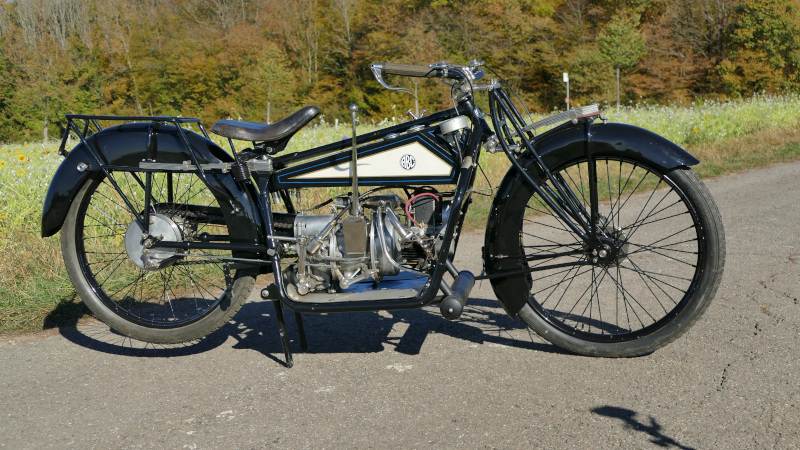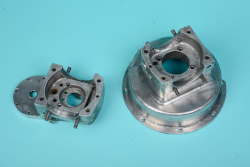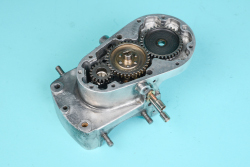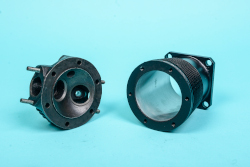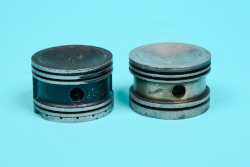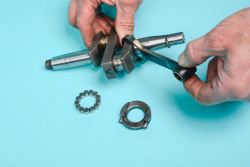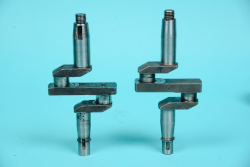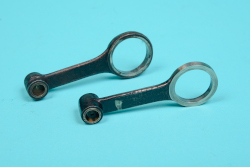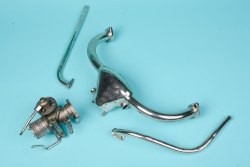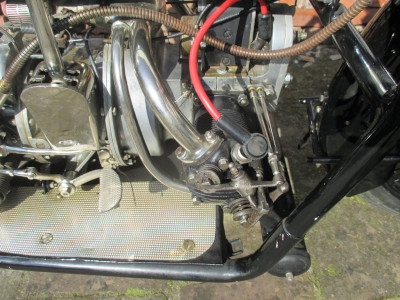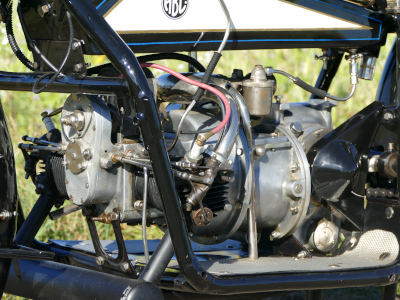The All British (Engine) Company’s ohv boxer engine is quite an exceptional piece of technology. It is said that Max Friz, designer of the BMW R32, once took a closer look at it.
We have done the same!
Positioned across the frame, flat-twin engines existed in motorcycle history long before BMW. In particular, ABC made a special contribution to the subject at the end of 1919: a short-stroke 400cc packed with many exciting details!
“When the engine is set correctly, the cylinder heads must glow cherry-red at night”: this is how Granville Bradshaw described one of the properties of his newly developed engine in 1919.
As a shareholder and the design-genius of ABC, he knew very well what he wrote in the ABC handbook. The lightweight 400cc ohv boxer engine had been developed directly from an aircraft engine and was now to be used in motorcycles. Straight after World War I, ABC focused on designing and developing motorcycles to fit their own engines, and Bradshaw developed an initial prototype machine as part of a competition. The motorcycle was supposedly designed in one night and completed in eleven days!
ABC looked for partners who could take care of the manufacturing, and contacted the Sopwith Aviation Engineering Co. Ltd. Previous to that, in December 1917, they had promoted the creation of a Parisian company called Société Francaise des Moteurs ABC. A short time later, ABC brought on board the French aircraft engine manufacturer Gnome et Rhone, which had an excellent reputation in aircraft engine construction and was able to contribute with its experience to improving ABC engines. Gnome et Rhone gained the rights to Patents, modified whatever made sense and in October 1919 presented to the authorities its first French manufactured ABC.
In December 1919 the time had come: The Gnome-Rhöne ABC was ready to go on sale.
The engine of such a French ABC from 1920 lies now dismantled in front of us, and next to it is placed its English counterpart, kindly lent to us by Wolfgang Staab, collector, and owner of a British ABC. This allows for interesting comparisons.
The crankcase is not a one-piece casting as is used by many flat twins, e.g., BMW, but is divided vertically in a plane between the cylinders. Naturally, the crankcase halves house the crankshaft main bearings.
In addition, the front half includes the timing chest, with a gear train to drive the camshaft and magneto.
The rear half is flared out at its rear end to form a bell-housing: this is where the relatively heavy flywheel rotates and where the dry clutch is positioned. So far, then, for BMW and Zundapp fans, everything is very understandable. The early ABC prototypes had a sump, while the first production models, such as our 1920 engine, relied on total loss lubrication with a manual oil pump. This was later replaced by an automatic oil pump.
The turned from solid steel cylinders are amazingly delicate and light. With a standard bore of 68.5mm, their wall thickness is only 1.75mm allowing piston oversizes of up to 69mm! When put on a scale, each cylinder weighs only around 600 grams! Both the English and the French installed light-alloy pistons with plain concave tops, to face the similarly shaped combustion chambers. They carry two 2.5mm deep piston rings at the top and another at the bottom of the skirt. There are small holes in the piston skirt and there are also holes in the bosses of the floating gudgeon pins, to help with lubrication. The hollow gudgeon pin is located by mushroom end-pieces. With a diameter of 12mm, the gudgeon pin of the French engine is 1 mm thicker than the one in its English counterpart. It goes without saying that neither the pistons nor the 6.3mm thick connecting rods can be interchanged between the two variants.
In general, hardly any parts of the French boxers are interchangeable with their English counterparts, which - we suspect - is partially down to their respective Metric and Imperial dimensions. The one-piece steel crankshafts are of the same length and have the same stroke, but the journals and crankpins have different diameters. For example, the main bearing journal measures 19.34mm on English shafts and 20mm on French shafts.
The width of the rear main bearing on the English model is 22.27mm and has two roller bearings next to each other - on the French model it is 20mm wide and has two conventional ball bearings and an intermediate ring. It becomes more obvious with the flywheel taper: this angle is only 6.4 degrees on the French boxers but the ABC almost has a double slope. Of course, the flywheel is not interchangeable either.
We could continue listing similar examples for a long time bringing to the attention of the reader the different crankweb widths, parallel key designs and so on… but the distance between the connecting rods appears to be significant: the English are 2mm further apart than the French.
The connecting rods are single-piece forgings with closed big-end eyes, they appear very light like so much else on this engine and are threaded over the crankshaft during assembly before the bearing rollers are inserted. Two-piece collars round each crank pin limit the axial play of the connecting rod and hold the rollers in place.
The camshaft is gear-driven, the push rods operate in the cooling air flow in front of the cylinders and act on the ends of the rocker arms, which actuate the valves.
The English guide to valve clearances is very practical: the inlet clearance should permit insertion of tissue-paper, the exhaust should permit newspaper!
The heads themselves are finely cast, have hemispherical combustion chambers and angled valves, with small wedges inserted through them to hold valve-spring collars in place. A tee-headed finger is screwed onto each head, which supports the two rockers, with associated washers and circlips. A grease nipple on the end of each arm of the tee seals it off: heat-resistant grease is called for. There is much to suggest that we are dealing with potentially weak points of the ABC engines in the valve train and cylinder head because various modifications had to be made time and again to the valve train during the entire development and production period.
The magneto-ignition system had proven itself. The magneto has found its place on the front half of the crankcase. While the English motorcycle relied on CAV, the French installed a Lavalette magneto on our model. The ignition was adjusted from the handlebars.
TECHNICAL DATA ABC 398 (1920)
Engine design: two-cylinder boxer, air-cooled, ohv valve control via gear-driven camshaft, push rods and rocker arms, total-loss lubrication, magneto ignition (C.A.V. or Lavalette/Paris). Carburettor (Zenith or Claudel Hobson)
Capacity: 398cc (Bore and stroke: 68.5 x 54 mm)
Power: about 8hp at the gearbox output
Transmission: dry single plate clutch, four-speed gearbox, secondary chain
What is the bottom-line impression of this more than 100-year-old construction? Granville Bradshaw was passionate about small internal combustion engines which run at high speeds (but later also played a major role in shaping the large Panther long-stroke engines). He had a vision of 250cc. engines with rated speeds of up to 10,000 rpm(!), and some of the ABC short-stroke engines, which weigh just 17 kilograms, reflect this credo.
There is talk of around 2,300 English and around 1,300 French motorcycles with the 398cc engine having been produced - a remarkable number - and racing successes were also achieved!
FROM THE HISTORY BOOKS
The ABC motorcycles were ...
... far ahead of their time, also in terms of frame design.
Not only the front wheel was sprung, but the rear wheel was mounted on a swinging fork, controlled by leaf springs. Drum brakes on both front and rear wheels, a rarity at the time which provided good deceleration. The production costs were correspondingly high, and the machines initially had weaknesses. Piston seizures, broken valves, lost pushrods and inadequate lubrication made things difficult for the early models. Over the years, the British have repeatedly optimized the construction and made it more stable. In racing, the 400cc ABC reached average speeds of over 110 km/h (!).
In 1935 the ABC experienced a short revival when the Gnome et Rhone expert Andre Barthelemy achieved speeds of up to 135 km/h with a half-litre boxer with two carburettors, a new crankshaft and new heads.
Close view of the 1920 ABC Gnome et Rhone engine.
Over and over, one reads that Max Friz borrowed less from the German Helios machine than from ABC when designing the BMW R32. In English literature, of course...
It should be noted that Bradshaw gave his motorcycle a fine four-speed gearbox (where Friz settled for three gears with his R32) but he missed the opportunity of the prop-shaft drive, or at least did not seize it.
The experts
Naming a single expert for English ABC motorcycles is hardly possible. But it’s worth checking out www.abcroadmotors.co.uk. Here you will find catalogues, parts on offer, photos and a global forum.
Special thanks to Giovanni Orlando, webmaster, for his great support!
The French ABC and Gnome et Rhone expert is undoubtedly Daniel David and it is possible to communicate with him in French via the Forum on the above website.
Text: Hans Juergen Huse.
Photos: Andreas Beyer.
With the friendly authorization by the German journal for classic cars and motorbikes “OldtimerPraxis”.

